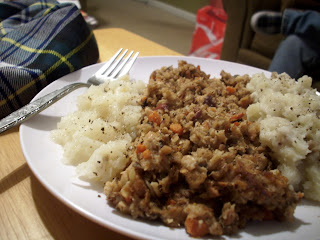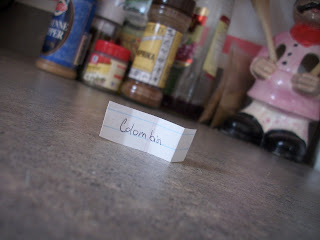After Courtney drew week 9's selection, I received an e-mail from my mom saying "Don't cry--it's Argentina!" I certainly didn't cry--I was quite pleased with the selection! Although I was a bit disappointed with the first experience I had with Argentinian culture (seeing Evita on stage last fall), I was quite pleased to delve into Argentinian cuisine. It's a unique cuisine in that not only does it hold true to its regional characteristics (South American styles), but it also has a very strong tie to its European connection.
Courtney jumped in and researched recipes for Argentina and came up with some great options right off the bat. We knew that we had to try the Argentinian staple chimichurri sauce, so in addition to that Courtney found recipes for side items - Receta por Berenjenas en Escabeche (an eggplant side dish) and Ensalada Rusa, a European-inspired potato salad. She also found a recipe for empanadas that she really wanted us to try (a margherita version, which emphasized the Italian flavors of mozzerella cheese, fresh tomato and basil), but mom and I talked her out of it since we weren't quite convinced of its authenticity as well as the fact that we just had the Russian counterpart the week before. The menu we agreed upon was quite delicious though (I also told Courtney we could try the empanada recipe she found another time--don't let me forget!).
 |
| Chimichurri sauce |
The menu we decided upon was Costillas Con Chimichurri, Receta por Berenjenas en Escabeche and Ensalada Rusa. Costillas con chimichurri (literally "ribs with chimichurri") I somewhat cheated with--instead of short ribs, I opted for top round steak. The berenjenas en escabeche (eggplant in brine) was a recipe we insisted upon since we've had an eggplant in our refrigerator since Japan week that had to be used! The ensalada rusa (Russian Salad) was an interesting find and tie-in to the previous week's fare and according to Courtney's research is hugely popular in everyday Argentinian fare. All of the ingredients were readily available at the local grocery store, so it's a very accessible menu for all who'd like to try it. Courtney found all of the recipes from From Argentna with Love, a food blog dedicated to Argentinian food. The one menu item we wanted to include but had a difficult time finding was mate tea, but the meal was quite satisfactory without it.
 |
| Peas and carrots for Ensalada Rusa |
The chimichurri sauce was very flavorful and easy to prepare--while I used dried parsley and curled-leaf parsley, the flavors were still distinct and delicious! The most difficult part was chopping the herbs to the right size, which was not too difficult at all. The ensalada rusa was also very easy, as well--we simply had to boil the potatoes and the carrots and peas and mixed them with the dressing (in which we substituted sour cream for mayo--which we somehow were out of at the house--but the sour cream ended up working very well). The eggplant (berenjenas en escabeche) took the most work of the three dishes--first it had to sit in salt for an hour or so, and then simmered in water and vinegar. I actually ruined the eggplant by letting it simmer at too high of a temperature and causing all of the vinegar to be absorbed very quickly which resulted in a highly-vinegary eggplant concoction--I would STRONGLY advise anyone interested in the eggplant recipe to keep a close eye on it while it cooks and to simmer at a fairly low heat.
 |
| Simmering eggplant |
The chimichurri sauce was a big hit--I enjoyed it more than the meat itself, actually--I would definitely recommend preparing the beef short ribs to have with it rather than the top round steak. The ensalada rusa was also a great hit--the potato and pea and carrot salad is a recipe I certainly plan on bringing to a church potluck in the future! As I mentioned before, the eggplant (berenjenas en escabeche) was an unfortunate victim to my hasty cooking, but the pickled eggplant recipe looked promising and I'd like to try it again. Overall, I would recommend this menu to you all--especially the chimichurri and the ensalada rusa--both would be exotic yet simple additions to your family's weekly dinner menu.
 |
| The completed meal |
Week 10's selection, the Australian Outback, is coming up next--and no, we're not having "shrimp on the barbie"! Check back in soon to find out about our next stop on our adventure around the world!






















